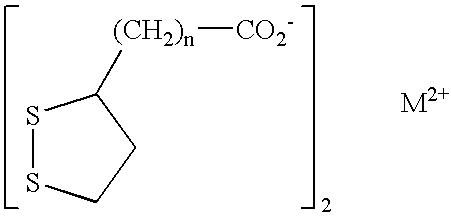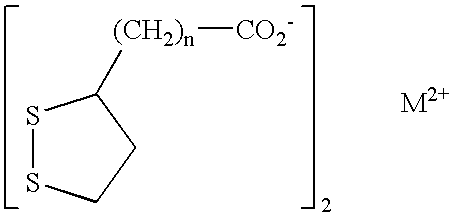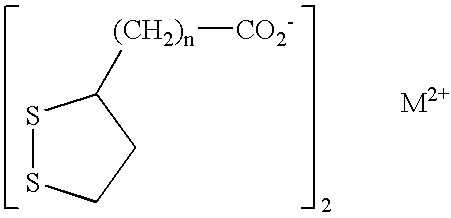Phosphorus binder for treatment of kidney disease
a technology of phosphorus binder and kidney disease, applied in the field of oral compositions, can solve problems such as hyperphosphatemia and associated pathologies, and achieve the effect of preventing hyperphosphatemia and reducing the amount of dietary phosphate absorbed
- Summary
- Abstract
- Description
- Claims
- Application Information
AI Technical Summary
Benefits of technology
Problems solved by technology
Method used
Image
Examples
example 1
[0055] Theoretical calculations of Phosphorus (Pi) binding as a measure of its ability to form phosphate salts. Phosphorus binding results from reaction of a cation with Pi to form an insoluble cation-phosphate salt. Equilibrium constant expressions for the chemical reactions involved in the interactions of Pi and calcium salts (Table 2) have been used to calculate theoretical binding of Pi by calcium succinate. Theoretical calculations are based on the chemical reaction in which inorganic phosphate (H2PO41−, HPO42−, and / or PO43−) that is in solution with a metal ion reacts to form insoluble metal phosphate salts.
[0056] In the discussion that follows, binding at equilibrium has been estimated by calculating the total amount of phosphate that could exist in a saturated solution of the binder cation-phosphate precipitate in the presence of the excess binder at the particular pH of interest. The binding reaction is the formation of the insoluble phosphate(s): aB+bP=BaPb (S) (where B=b...
example 2
[0061] In vitro Assessment of Phosphate (Pi) Binding by Calcium Succinate. Test Preparations: Solutions of the test article (calcium succinate) and control articles (calcium acetate) were prepared in deionized, purified water having 18 MΩ or greater resistance. The pH of each solution was adjusted to the desired value by the addition of concentrated hydrochloric acid or sodium hydroxide, as appropriate.
[0062] Tests and Assays: Calcium succinate was assayed as described in the U.S. Pharmacopoeia by dissolving an accurately weighed sample in water containing hydrochloric acid, adding hydroxynapthol blue as an indicator, and titrating to a blue endpoint with edetate disodium solution. An HPLC method with conductivity detection was developed and validated for use in the determination of succinate, acetate and phosphate. The separation was performed on a Dionex AS11 Cation-Exchange HPLC column integrated with an Agilent Series 1100 HPLC system, and detection of the anionic species was e...
example 3
[0067] Phosphate Binding by Magnesium Salts. This study was reported by Fine et al. [Fine K D, Santa Ana C A, Porter J L, Fordtran J S. Intestinal absorption of magnesium from food and supplements. J Clin Invest 1991; 88: 396-402.] Magnesium absorption over a wide range of intakes to which the intestine may be exposed from magnesium-containing medications was measured in eight healthy male subjects, aged 25-35 years old, after they ingested a standard meal supplemented with 0, 10, 20, 40, and 80 mEq of magnesium acetate. (Data in Table 4 are taken from Table 3, page 399 of the Fine et al. publication.) These data show that although absorption increased with each increment in intake, fractional magnesium absorption fell progressively from 65% at the lowest to 11% at the highest intake. These results are compatible with a mechanism of magnesium absorption that reaches an absorptive maximum, together with a mechanism that endlessly absorbs a defined fraction (7%) of ingested magnesium....
PUM
| Property | Measurement | Unit |
|---|---|---|
| Volume | aaaaa | aaaaa |
| Volume | aaaaa | aaaaa |
| Volume | aaaaa | aaaaa |
Abstract
Description
Claims
Application Information
 Login to View More
Login to View More - R&D
- Intellectual Property
- Life Sciences
- Materials
- Tech Scout
- Unparalleled Data Quality
- Higher Quality Content
- 60% Fewer Hallucinations
Browse by: Latest US Patents, China's latest patents, Technical Efficacy Thesaurus, Application Domain, Technology Topic, Popular Technical Reports.
© 2025 PatSnap. All rights reserved.Legal|Privacy policy|Modern Slavery Act Transparency Statement|Sitemap|About US| Contact US: help@patsnap.com



